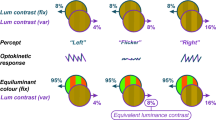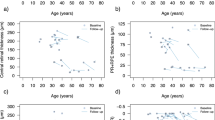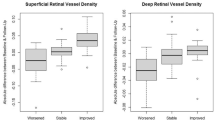Abstract
Purpose
To better understand the reference values and adequate discrimination values of colour vision function with described quantitative systems for the Lanthony desaturated D-15 panel (D-15DS).
Methods
A total of 1042 Japanese male officials were interviewed and underwent testing using Ishihara pseudoisochromatic plates, standard pseudoisochromatic plates part 2, and the D-15DS. The Farnsworth–Munsell (F–M) 100-hue test and the criteria of Verriest et al were used as definitive tests. Outcomes of the D-15DS were calculated using Bowman's Colour Confusion Index (CCI). The study design included two criteria. In criterion A, subjects with current or past ocular disease and a best-corrected visual acuity less than 0.7 on a decimal visual acuity chart were excluded. In criterion B, among subjects who satisfied criterion A, those who had a congenital colour sense anomaly were excluded.
Results
Overall, the 90th percentile (95th percentile) CCI values for criteria A and B in the worse eye were 1.70 (1.95) and 1.59 (1.73), respectively. In subjects satisfying criterion B, the area under the receiver operating characteristic curve was 0.951 (95% confidence interval, 0.931–0.971). The CCI discrimination values of 1.52 or 1.63 showed 90.3% sensitivity and 90% specificity, or 71.5% sensitivity and 95% specificity, respectively, for discriminating acquired colour vision impairment (ACVI).
Conclusion
We provided the 90th and 95th percentiles in a young to middle-aged healthy population. The CCI is in good agreement with the diagnosis of ACVI. Our results could be helpful for using D-15DS for screening purposes.
Similar content being viewed by others
Log in or create a free account to read this content
Gain free access to this article, as well as selected content from this journal and more on nature.com
or
References
Verriest G, Van Laethem J, Uvijls A . A new assessment of the normal ranges of the Farnsworth–Munsell 100-hue test scores. Am J Ophthalmol 1982; 93: 635–642.
Mantyjarvi M . Normal test scores in the Farnsworth–Munsell 100-hue test. Doc Ophthalmol 2001; 102: 73–80.
Roy MS, Podgor MJ, Collier B, Gunkel RD . Color vision and age in a normal North American population. Graefes Arch Clin Exp Ophthalmol 1991; 229: 139–144.
Gobba F, Cavalleri A . Color vision impairment in workers exposed to neurotoxic chemicals. Neurotoxicology 2003; 24: 693–702.
Gobba F, Cavalleri A . Evolution of color vision loss induced by occupational exposure to chemicals. Neurotoxicology 2000; 21: 777–781.
Iregren A, Andersson M, Nylen P . Color vision and occupational chemical exposures: I. An overview of tests and effects. Neurotoxicology 2002; 23: 719–733. Review.
Urban P, Gobba F, Nerudova J, Lukas E, Cabelkova Z, Cikrt M . Color discrimination impairment in workers exposed to mercury vapor. Neurotoxicology 2003; 24: 711–716.
Gobba F . Related Color vision: a sensitive indicator of exposure to neurotoxins. Neurotoxicology 2000; 21: 857–862.
Farnsworth D . The Farnsworth–Munsell 100-Hue Test Manual (Revised). Munsell Color Co.: Baltimore, 1957.
Fong DS, Barton FB, Bresnick GH . Impaired color vision associated with diabetic retinopathy: Early Treatment Diabetic Retinopathy Study Report No. 15. Am J Ophthalmol 1999; 128: 612–617.
Bowman KJ . A method for quantitative scoring of the Farnsworth Panel D-15. Acta Ophthalmol (Copenh) 1982; 60: 907–916.
Vingrys AJ, King-Smith PE . A quantitative scoring technique for panel tests of color vision. Invest Ophthalmol Vis Sci 1988; 29: 50–63.
Bassi CJ, Galanis JC, Hoffman J . Comparison of the Farnsworth–Munsell 100-Hue, the Farnsworth D-15, and the L'Anthony D-15 desaturated color tests. Arch Ophthalmol 1993; 111: 639–641.
Good GW, Schepler A, Nichols JJ . The reliability of the lanthony desaturated D-15 test. Optom Vis Sci 2005; 82: 1054–1059.
Iregren A, Andersson M, Nylen P . Color vision and occupational chemical exposures. II. Visual functions in non-exposed subjects. Neurotoxicology 2002; 23: 735–745.
Melamud A, Hagstrom S, Traboulsi E . Color vision testing. Ophthalmic Genet 2004; 25: 159–187.
Vu BL, Easterbrook M, Hovis JK . Detection of color vision defects in chloroquine retinopathy. Ophthalmology 1999; 106: 1799–1803.
Gobba F, Cavalleri A . Color vision impairment in workers exposed to neurotoxic chemicals. Neurotoxicology 2003; 24: 693–702.
Lawrenson JG, Kelly C, Lawrenson AL, Birch J . Acquired colour vision deficiency in patients receiving digoxin maintenance therapy. Br J Ophthalmol 2002; 86: 1259–1261.
Third Report of the National Cholesterol Education Panel (NCEP) Expert Panel on Detection, Evaluation, and Treatment of High Blood Cholesterol in Adults (Adult Treatment Panel or ATP III). NIH Publication No. 01-3305 May 2001.
American Diabetes Association. Standards of medical care in diabetes-2006. Diabetes Care 2006; 29 (Suppl 1): S4–S42.
Kessel L, Alsing A, Larsen M . Diabetic versus non-diabetic colour vision after cataract surgery. Br J Ophthalmol 1999; 83: 1042–1045.
Cavalleri A, Gobba F, Nicali E, Fiocchi V . Dose-related color vision impairment in toluene-exposed workers. Arch Environ Health 2000; 55: 399–404.
Alcala A, Morell M, Rius F . Comparative study of the impact of diet versus pravastatin on color vision in Brodman area 19 detected by computerized chromatic analysis (CARDIOCOLOUR Study). Rev Esp Cardiol 2002; 55: 1243–1250.
Ihrig A, Nasterlack M, Dietz MC, Hoffmann J, Triebig G . Pilot study on prevalence of color vision dysfunction in long-term solvent-exposed painters. Ind Health 2003; 41: 39–42.
Woo GC . Are ethnic differences in the F–M 100 scores related to macular pigmentation? Clin Exp Optom 2002; 85: 372–377.
Baird B, Camp J, Daniell W, Antonelli J . Solvents and color discrimination ability. Nonreplication of previous findings. J Occup Med 1994; 36: 747–751.
Acknowledgements
The authors thank The Okubo Color Study team, in particular, K Tanaka for subject recruitment; A Katagiri for helping in preparing the study; K Sintomi, Y Usuda, T Kanazaki, N Nakai, Y Komatsu, and T Bessho for clinical input; and the volunteers for participating in the study. In addition, we thank Ms Lynda Charters for her linguistic and editorial support.
Author information
Authors and Affiliations
Corresponding author
Additional information
The authors have no proprietary interest in any aspect of this study
Rights and permissions
About this article
Cite this article
Shoji, T., Sakurai, Y., Chihara, E. et al. Reference intervals and discrimination values of the Lanthony desaturated D-15 panel test in young to middle-aged Japanese army officials: the Okubo Color Study Report 1. Eye 23, 1329–1335 (2009). https://doi.org/10.1038/eye.2008.292
Received:
Accepted:
Published:
Issue date:
DOI: https://doi.org/10.1038/eye.2008.292



